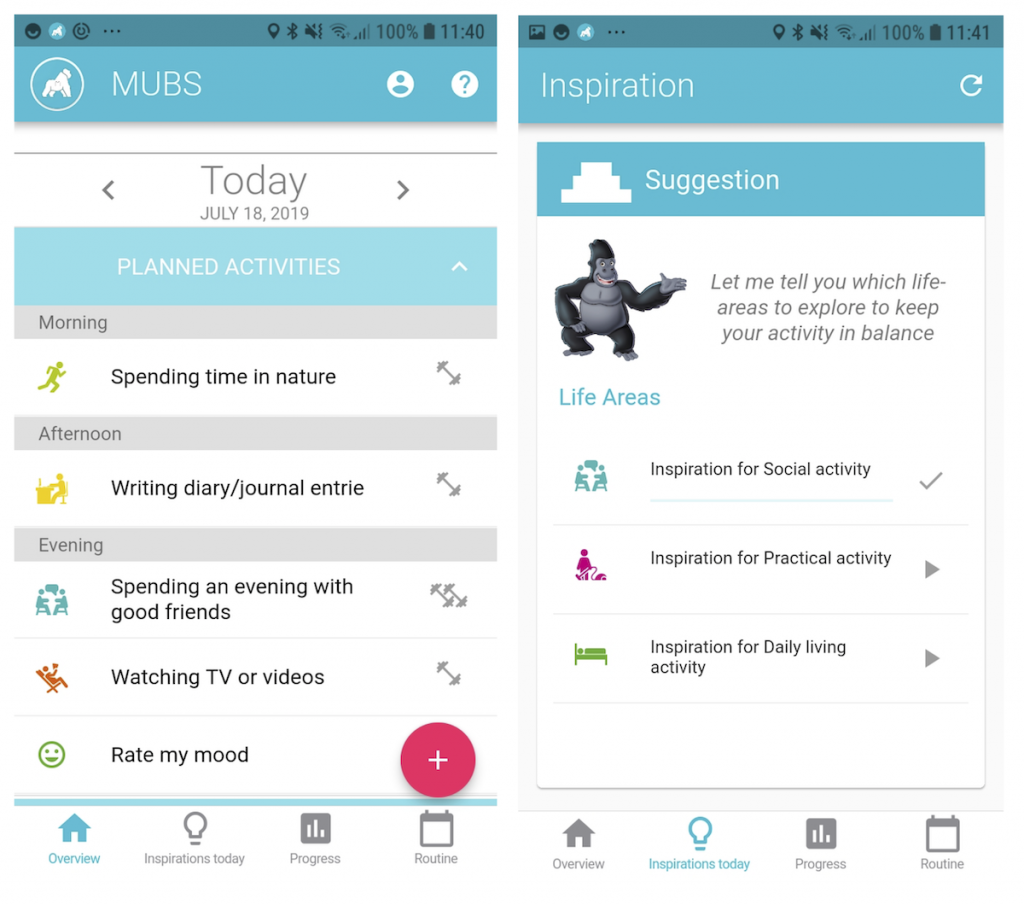MUBS – is a smartphone-based recommender system for the treatment of depressive symptoms. Adhering to the principles of Behavioral Activation (BA) therapy, MUBS aims to reinstate (i.e., recommend) pleasant activities back into the lives of patients with depressive symptoms. MUBS utilizes a content-based probabilistic technique with a catalog of 384 pleasant activities in order to recommend activities personalized to the individual user. MUBS is designed as a stand-alone tool to be used both as part of BA therapy as well as outside therapy.
MUBS [1] was designed following a user-centered design process involving an interdisciplinary set of clinical (psychiatrists, psychologists, and nurses) and technical (computer scientists, UX designers, and biomedical engineers) professionals who worked closely with four patients diagnosed with a depressive or bipolar disorder.

Aims
As a result of this design process, MUBS has the following aims:
- MUBS should support activity tracking and registration since this is core to the BA methodology. Activity registration takes place morning, afternoon, and evening, with a ‘pleasure’ score as a simple ‘thumbs-up/down’ approach. In this way, activity registration was considerably simplified compared to the traditional BA approach.
- MUBS should support activity planning – another core component of BA. But instead of using a calendar with detailed information on timing, a more simple approach was used in MUBS where activities can be added ‘somewhere during the day’.
- MUBS should inspire the patient to identify, plan, and perform healthy activities, which is a BA component normally supported by a therapist. The approach is to have MUBS assist in recommending activities, thereby inspiring healthy behavior. Two features were designed to accommodate this; (i) a catalog of inspirational activities, and (ii) the recommender algorithm presented above, which can be trained to learn the patient’s activity preferences and then propose personalized activities.
- MUBS is designed to work independently of the clinic and the therapist, and be designed as a self-management tool for engaging the patient in BA. The system should inspire the patient to plan and track activities in-between therapy sessions or even when no longer in therapy. Hence, even though MUBS can be used as part of clinical treatment, the main aim is to support self-efficacy.
Technical use of CARP
MUBS utilize CAMS for collection of contextual data including location, weather, noise, step counts, and activity. All of this is uploaded to Firebase using the CAMS Firebase backend plugin.
References
- Rohani, D. A., Quemada Lopategui, A., Tuxen, N., Faurholt-Jepsen, M., Kessing, L. V., & Bardram, J. E. (2020, April). MUBS: A personalized recommender system for behavioral activation in mental health. In Proceedings of the 2020 CHI Conference on Human Factors in Computing Systems (pp. 1-13).
- Rohani, D. A., Faurholt-Jepsen, M., Kessing, L. V., & Bardram, J. E. (2021). Benefits of Using Activity Recommender Technology for Self-management of Depressive Symptoms. ACM Transactions on Computing for Healthcare, 2(4), 1-21.
- Rohani, D. A., Springer, A., Hollis, V., Bardram, J. E., & Whittaker, S. (2020). Recommending activities for mental health and well-being: Insights from two user studies. IEEE Transactions on Emerging Topics in Computing, 9(3), 1183-1193.